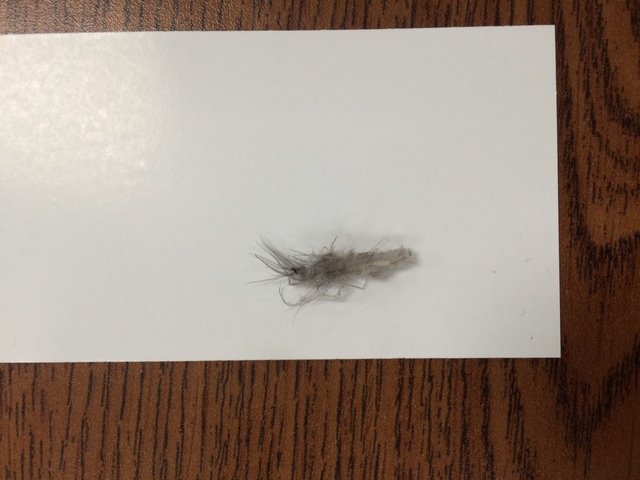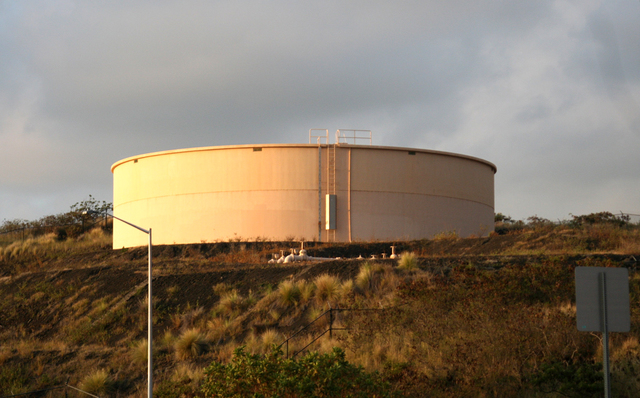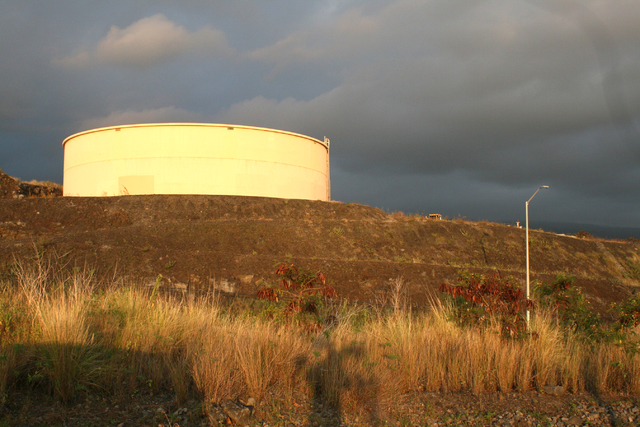Red flag raised after what may have been bird feathers found inside showerhead
KAILUA-KONA — Layne Howard of LNH Plumbing last week received what appeared to be a routine service call. It turned out to be anything but.
A showerhead in one of the units at Keauhou-Kona Surf and Racquet Club on Alii Drive was clogged. Howard assumed a simple issue with flow restrictors, implemented to minimize gallon-per-minute water usage. He thought, perhaps, construction on a water main may have deposited a small amount of gravel in the pipes, which can occasionally happen and cause a clog.
But when he pulled off the showerhead, he witnessed something he’d never seen before, and something he couldn’t have expected. The sources of the clog were what appeared to be a few small bird feathers.
“I’m not a scientist, and I can’t say for certain those were feathers, but they sure looked like feathers to me,” Howard said. “There is no way for feathers to get to that point in the system unless they came from the main water source, because everything from where the county pumps water out of their storage tanks to the individual customers is a closed system, so it was kind of freaky. I thought this could be ugly and people could get sick, and that’s why I raised the red flag.”
Part of Howard’s worry stemmed from the notion that if a bird had been sucked into the system, it would have been eventually ground up by the pumps and potentially dispersed in tiny fragments to several properties.
But county water experts said conventional wisdom renders the scenario posed by Howard highly improbable.
Water tight
Keith Okamoto, manager and chief engineer at Hawaii County Department of Water Supply, said it is extremely unlikely a bird or any animal could have ended up in the water system, adding it was even less likely it could have made its way all the way to showerhead in a residential complex.
“From our perspective, we don’t see that as being possible,” Okamoto said.
The sources of the county water system are several drilled wells, which are sealed off and monitored on a more or less daily basis. The water is treated at the well head with chlorine via mandated health requirements and from there is pumped into various reservoir tanks across the island.
Four such tanks service different areas of Alii Drive, as well as other portions of their designated geographic regions.
From the tanks, effluent pipes near the bottom of the structures circulate water to homes and businesses using gravity and pumps, which are also entirely sealed off.
Rob Ravenscraft, water service district supervisor in Kona, said there are also internal screens at all the meters to catch anything before the water enters private plumbing systems — for instance any gravel that may have accumulated due to construction, although even that is unlikely as pipes are flushed after construction.
Finally, in residential areas, backflow preventers are frequently employed, which would be another barrier to any water-borne contaminant finding its way into a personal water supply.
The reservoir tank sites themselves are protected by several security measures to safeguard against human or natural contamination. There are, however, vents on the storage tanks.
The vents, which are built into the tank system to control air pressure, are protected by mesh screens. Those screens, which are located near the top of vertical walls standing several feet high, are the only potential entry point for any animal to breach the otherwise entirely closed system. The only animals with even a remote potential to infiltrate the tank vents would be those able to fly.
“Our system is essentially sealed,” Okamoto said. “If a bird were to get into the tank, for it to get sucked all the way down to that effluent pipe (at the bottom of the structure), the tank would have to have been drained.”
Indicators yet absent
Because any given reservoir services so many properties, Okamoto said almost every time the system has had any sort of issue it has resulted in an avalanche of calls by several affected consumers. Thus far, that hasn’t happened.
Bacteria levels are also monitored with frequency, and the presence of a contaminant such as a bird would cause “a sharp decline in chlorine residual levels that test out of distribution.” Such a decline has yet to be observed.
But Okamoto acknowledged the possibility of a bird breaching the system, while in his opinion incredibly unlikely, could not be dispelled with complete certainty, as screens can suffer damage due to weather or general wear and tear. While well sources are monitored obsessively, Ravenscraft said tank screens are probably only checked once or twice every month.
“Those screens are checked regularly as part of our normal routine of checking the sites, and they are also checked every five years by the state,” Ravenscraft explained. “We spend a lot of time looking for potential problems. The only way a bird would have gotten into a tank is through a screen. From our end, that would be a really bizarre thing. In 28 years, I’ve never had anything organic in our system.”
Response
Howard alerted the Department of Water Supply of his concerns last week, on the same day he brought the issue to the attention of the West Hawaii Today. Okamoto didn’t learn of the issue until the the newspaper’s inquiry into the matter Wednesday, however.
Okamoto made it a point to assure residents that extra vent screen inspections will be undertaken promptly throughout the department’s Kona District. He was also adamant there is little cause for mass concern, as there is still no confirmation any animal entered the system.
He added if a bird did somehow find its way into the water supply, it’s more than likely it’s an isolated incident and occurred on site at the Surf and Racquet Club.
Ravenscraft agreed.
“I could see it happening on the customer’s end somewhere if there was some work being done and something happened to get into the pipe,” Ravenscraft said.
Howard also notified Albert Prados, the property manager at the Surf and Racquet Club, of the suspicious material he found in the showerhead. Prados said he couldn’t confirm whether the material came from a bird or not, as he only heard about it secondhand.
He added that he’s not encountered a similar problem before last week’s incident or since. As of Wednesday, he had not been contacted by the county Department of Water Supply.
Prados could not be reached Friday by press time to address a follow-up question regarding whether any recent plumbing construction had taken place on site.





